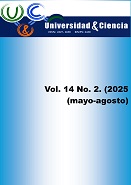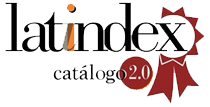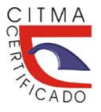Retrospective study of feed conversion in guinea pigs (Cavia porcellus) between 2020 and 2024, scientists
DOI:
https://doi.org/10.5281/zenodo.15848546Keywords:
bibliometric method, feed conversion, guinea pigsAbstract
Introduction: In livestock farming the calculation of feed conversion is crucial to evaluate the efficiency in which animals transform feed into biomass. Objective: To compare feed conversion rates in guinea pigs, using data from national studies between 2020-2024 and from the Research Center of the Faculty of Agricultural Sciences and Natural Resources (FCAREN) of the Technical University of Cotopaxi (UTC). Method: The bibliometric method was used to collect data in national studies and to obtain the feed conversion at FCAREN - UTC, an experiment was carried out in the facilities of the institution with a duration of 45 days, divided into two stages, rearing and fattening. Results: An analysis of variance revealed differences in feed conversion rates (P< 0.01), both in the rearing and fattening stages. When comparing the data obtained with the bibliometric data, it is established that the mixed feeding systems showed the most efficient indexes in the rearing stage at FCAREN-UTC, with a feed conversion ratio of 3.72 and in national studies of 3.83. The concentrate feeding system showed low feed conversion ratio especially in the fattening stage (8.27 and 7.03 in national studies and FCAREN-UTC, respectively). Conclusion: These findings highlight the importance of a balanced nutrition combining forage and concentrate to improve feed efficiency, in addition to the influence of the stage of the guinea pig on feed efficiency.
Downloads
References
Adebowale T, Yao K, y Oso A. (2019.). Major cereal carbohydrates in relation to intestinal health of monogastric animals: a review. Anim Nutr. 5(4), 331-339. https://doi.org/10.1016/j.aninu.2019.09.001
Aguilar I., Palza D., Condor N., Limache I., y Argota G. (2024). Peso total de cuyes en condiciones de alimentación con forraje verde hidropónico de cebada, maíz chala y concentrado. Cuban Journal of Agricultural Science, 58. http://scielo.sld.cu/scielo.php?script=sci_arttext&pid=S2079-34802024000100004&lng=es&tlng=e
Aldaz J. (2024). Comportamiento productivo en cuyes (Cavia porcellus) utilizando afrecho de arroz en la dieta alimenticia durante la etapa de crecimiento y engorde. Ab Intus, 7(14), e0158.
http://www.ayv.unrc.edu.ar/ojs/index.php/Ab_Intus/article/view/146
Chavez L., y Avilés D. (2022). Caracterización del sistema de producción de cuyes del cantón Mocha, Ecuador. Revista de Investigaciones Veterinarias del Perú. 33 (2), e22576 http://dx.doi.org/10.15381/rivep.v33i2.22576
Cjanahuire E., Ramos L., Telles R., Padilla M., y Aybar H. (2023). Efecto de la alimentación en la productividad del cuy (Cavia porcellus) en la fase de desarrollo. Alfa Revista de Investigación en Ciencias Agronómicas y Veterinaria. 7 (21) 567 – 572. https://doi.org/10.33996/revistaalfa.v7i21.237
Escobar F., Ruíz J., Benavides, R., Ruggerths., Nilo., y Ruíz, D. (2023). Efecto de la edad sobre el peso y rendimiento de la canal y masa muscular en cuyes (Cavia porcellus) en crecimiento y engorde. Journal of the Selva Andina Animal Science.10(1), 39-51.https://doi.org/10.36610/j.jsaas.2023.100100039
Guamán M., Usca J., Díaz H., y Castillo B. (2018): Evaluación de dos raciones tradicionales para la alimentación de cuyes mejoradas desde el destete hasta el inicio de la vida reproductiva, mediante la utilización de madrigueras en forma piramidal. Revista Caribeña de Ciencias Sociales. 6. https://dialnet.unirioja.es/servlet/articulo?codigo=9736701
Guamán S., Herrera F., Ruiz C., y Correa S. (2023). Respuestas productivas de cuyes (Cavia porcellus) suplementados con Cúrcuma (Curcuma longa). Código científico. Revista de investigación, 4(1), 787–807. https://doi.org/10.55813/gaea/ccri/v4/n1/145
Huaman D., Huayhua J., Acosta E., Palomino W., y Valverde P. (2021). Comportamiento productivo en cuyes (Cavia porcellus) machos raza Perú bajo el efecto de tres sistemas de alimentación, criados en condiciones de valles interandinos del Perú. Agroindustrial Science. 11(2), 179-183 https://doi.org/10.17268/agroind.sci.2021.02.07
Nieto E., Malta Y., Jácome A., Velesaca P., Garay G., Murillo Y., Rosales C., y Urdaneta M. (2023). Valoración de dietas simples y mixtas para engorde de cobayos (Cavia porcellus) nativos de los Andes del Ecuador. Rev. Cient. FCV-LUZ. 33(2), 1 https://doi.org/10.52973/rcfcv-e33259
Núñez O., Guerrero J., Borja B., y Vaca C. (2023). Comportamiento de los índices productivos en cuyes utilizando avena de corte e hidropónica. Revis Bionatura, 8(3),4. https://revistabionatura.com/files/Vol-6-N-4.pdf
Quispillo N., Méndez J., Tello L., y Reinoso A. (2021). Making Nutritional Blocks Based on Scirpus rigidus (Totorilla) Flour for the Feeding and Fattening of Guinea Pigs. ESPOCH Congresses: The Ecuadorian Journal of S.T.E.A.M., 1(5), 1385 – 1399. https://doi.org/10.18502/espoch.v1i5.9580
Reynaga M., Vergara V., Chauca L., Muscari J., y Higaonna R. (2020). Sistemas de alimentación mixta e integral en la etapa de crecimiento de cuyes (Cavia porcellus) de las razas Perú, Andina e Inti. Revista de Investigaciones Veterinarias del Perú, 31(3), e18173.
Rojas L., Noboa T., Shagnay S., y Condo L. (2020). Alimentación de cuyes en la fase de crecimiento en base a gramíneas tropicales de Morona Santiago. Conciencia Digital. 3, 50-59. https://doi.org/10.33262/concienciadigital.v3i2.2.1245
Santana W., Monge M., Durazno L., y Muñoz R. (2023). Implementación de varios niveles de harina de botón de oro (Tithonia diversifolia) para cuyes (Cavia porcellus) en etapa de engorde. Revista Científica Ciencia Y Tecnología, 23(39), 73-82. https://doi.org/10.47189/rcct.v23i39.582
Tello L., Mendoza R., Wile L. y Gomer C. (2023). Alimentación de cuyes con harina de papa como sustituto del maíz amarillo y alfalfa. Alfa Revista de Investigación en Ciencias Agronómicas y Veterinaria. 7 (19), 130-138. https://doi.org/10.33996/revistaalfa.v7i19.203
Valverde P., Trujillo J., Díaz H, y Toalombo P. (2021). Alimentación de cuyes (Cavia porcellus) con pastos y forrajes de clima tropical en pastaza – ecuador bajo un sistema de crianza piramidal. Actas Iberoamericanas de Conservación Animal AICA. 16, 59-66.
Vásquez G., Cáceres F., y Zapata T. (2021). Comportamiento productivo de cuyes (Cavia porcellus L.) en crecimiento suplementados con prebióticos y probióticos naturales. Ciencia Y Tecnología Agropecuaria, 22(3), e1920. https://doi.org/10.21930/rcta.vol22_num3_art:1920
Yucailla V., Ríos D., Cuvi C., Acosta N., Pinos N., y Masaquiza D. (2022). Comportamiento productivo de Cavia porcellus en la fase de engorde con la inclusión de Curcuma longa como promotor de crecimiento. Revista UTCiencia. 8(3), 92-102. http://investigacion.utc.edu.ec/index.php/utciencia/article/view/372
Downloads
Published
How to Cite
Issue
Section
License
Copyright (c) 2025 Universidad & ciencia

This work is licensed under a Creative Commons Attribution-NonCommercial-ShareAlike 4.0 International License.





















